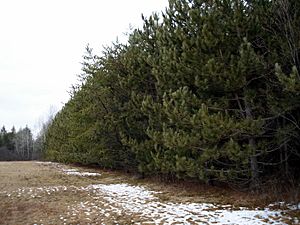Reforestation facts for kids
Reforestation is the process of planting new trees in areas where forests once stood. It can happen naturally, or people can intentionally plant trees. This is done to bring back forests and woodlands that have been lost, often due to deforestation.
Reforestation helps improve our lives in many ways. Forests clean the air by absorbing pollution and dust. They also create homes for animals and plants, helping to rebuild natural habitats and ecosystems. Planting trees is also a key way to fight global warming. Forests absorb carbon dioxide from the air, which is a gas that traps heat. This process is called carbon sequestration. Trees also provide resources like wood and other useful products from the forest.
Contents
Why Reforestation Matters
Reforestation is super important for our planet and for us. When forests are cut down, it causes many problems. Reforestation helps fix these problems and makes the Earth healthier.
Cleaning Our Air
Trees are like giant air filters. They take in harmful gases, like carbon dioxide, and release fresh oxygen. This helps keep the air we breathe clean and healthy. It also reduces the amount of pollution in the atmosphere.
Fighting Climate Change
One of the biggest benefits of reforestation is its role in fighting global warming. Forests absorb large amounts of carbon dioxide. This gas is a major cause of climate change. By planting more trees, we can remove carbon dioxide from the air. This helps to slow down global warming and its effects.
Protecting Wildlife and Nature
Forests are home to countless species of animals and plants. When forests are destroyed, these creatures lose their homes. Reforestation helps to rebuild these natural habitats. It allows wildlife to return and thrive, protecting Earth's amazing biodiversity.
Preventing Soil Erosion
Tree roots hold the soil in place. When forests are cut down, the soil can easily be washed away by rain or blown away by wind. This is called soil erosion. Reforestation helps prevent this, keeping the soil healthy for new plants to grow.
Providing Resources
Forests provide us with many useful things. We get wood for building, paper, and furniture. Forests also give us fruits, nuts, medicines, and other products. Reforestation ensures we continue to have these resources for the future.
How Reforestation Happens
Reforestation can happen in different ways. Sometimes, nature does the work itself. Other times, people need to step in and help.
Natural Reforestation
After a forest is cleared or burned, new trees can sometimes grow back on their own. Seeds might be carried by wind or animals. Young trees might sprout from old roots. This natural process can take a very long time.
Active Reforestation
When natural regrowth is too slow or difficult, people actively plant trees. This often involves growing young trees in nurseries first. Then, these seedlings are planted in the ground. This method is faster and more controlled.
Seed Sowing
Sometimes, instead of planting young trees, people spread seeds directly onto the land. This is called direct-sowing. It can be a good way to reforest large areas, especially after a fire.
Choosing the Right Trees
When planting trees, it's important to choose the right kinds. Experts select tree species that are native to the area. They also pick trees that will grow well in the local climate and soil. This helps create a healthy and strong new forest.
Challenges and Solutions
Reforestation is not always easy. There are many challenges, but people are working hard to find solutions.
Protecting Young Trees
Young trees are delicate. They need protection from animals that might eat them. They also need enough water and sunlight to grow strong. Foresters often use fences or shelters to protect new seedlings.
Dealing with Pests and Diseases
Like any living thing, trees can get sick or be attacked by pests. This can harm a reforestation project. Scientists work to find ways to keep trees healthy. They also try to plant different types of trees. This makes the forest stronger against diseases.
Funding and Support
Reforestation projects can be expensive. They need money for seeds, young trees, tools, and workers. Governments, organizations, and individuals all help fund these important efforts. Many people also volunteer their time to plant trees.
Images for kids
See also
 In Spanish: Reforestación para niños
In Spanish: Reforestación para niños






